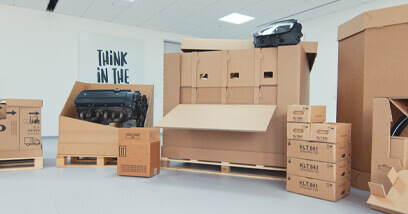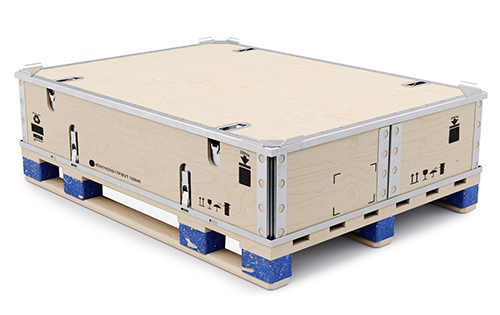Industrial Metal Packaging: Toughness and Resilience in Every Style
Wiki Article
Effective Industrial Recycling Solutions for Lasting Product Packaging: A Comprehensive Guide
That's where this comprehensive guide on efficient commercial recycling services for sustainable product packaging comes in. By exploring key areas such as packaging product selection, creating for recyclability, applying recycling facilities, working together with recycling partners, and tracking and determining reusing success, this guide will certainly equip you with the understanding and tools necessary to make enlightened choices and drive positive change within your organization. Whether you're a product packaging specialist, sustainability manager, or just interested in the topic, this overview will supply valuable insights and techniques to assist you navigate the world of lasting product packaging.Product Packaging Material Option
The choice of product packaging materials plays a crucial duty in ensuring the sustainability of commercial reusing solutions. When it involves sustainable packaging, the option of products is type in reducing environmental effect and making best use of reusing efficiency. Choosing the ideal products can aid reduce waste generation, conserve resources, and promote a round economic climate.One vital aspect to consider in product packaging material choice is recyclability - industrial packaging solutions. Products that can be conveniently reused and integrated back into the manufacturing cycle are chosen. Products like cardboard, paper, glass, and certain types of plastics can be reused several times without shedding their quality. On the other hand, products that are hard to reuse, such as mixed plastics or non-recyclable compounds, can produce challenges for the recycling procedure and might wind up in garbage dumps or burners.
One more consideration is using biodegradable and renewable products. Packaging made from renewable resources, such as plant-based plastics or biopolymers, can help in reducing dependence on nonrenewable fuel sources and minimize climate modification. In addition, biodegradable products damage down naturally in time, minimizing the build-up of waste in landfills.
Moreover, the weight and volume of packaging products ought to be reduced to lower transport expenses and energy intake. Lightweight materials not just require less resources during production yet additionally add to lower carbon exhausts throughout transport.
Designing for Recyclability
Product packaging designers should focus on the use of products that are widely approved for recycling and have established reusing frameworks. Products such as glass, aluminum, and specific types of plastic, like PET and HDPE, are frequently reused and need to be favored over materials that are costly or tough to reuse.An additional critical factor to consider in designing for recyclability is the elimination of unneeded elements or materials. By reducing the variety of layers, coverings, and extra elements, packaging can be made easier and much easier to reuse. Furthermore, developers must intend to lower making use of combined products, as they can make complex the recycling procedure.

Implementing Recycling Facilities
Reliable execution of reusing infrastructure is important for the success of commercial recycling solutions. Without appropriate framework in place, the recycling procedure becomes inefficient and ineffective, preventing the general goal of lasting packaging.To apply recycling framework successfully, several essential elements require to be taken into consideration. To start with, there should be an efficient collection system that promotes the separation and collection of recyclable materials. This can include designated reusing you can find out more containers in public spaces, along with partnerships with waste monitoring firms for curbside pickup and sorting.
As soon as gathered, the recyclable products need to be delivered to reusing centers in a prompt manner. This needs efficient logistics and transportation networks, ensuring that the products reach the appropriate centers immediately.
At the reusing centers, progressed sorting and handling innovations must be in area to divide different kinds of materials successfully. This includes using automated arranging makers, optical scanners, and hands-on sorting techniques.
Furthermore, there should be a durable market demand for recycled products. This can be accomplished via collaborations with makers and sectors that use recycled products in their production procedures. Creating a stable market for recycled materials incentivizes the recycling reference industry and advertises the circular economic situation.
Teaming Up With Recycling Partners

One trick element of collaborating with reusing companions is the establishment of clear communication networks. It is very important to establish open lines of communication to facilitate the exchange of details, updates, and responses. This enables both parties to remain informed concerning the development of reusing initiatives and address any type of difficulties or issues that might emerge.
Additionally, cooperation can include joint initiatives in creating and carrying out reusing programs. Reusing companions can supply beneficial understandings and advice in creating effective collection systems and determining the most ideal recycling innovations. By collaborating, companies and reusing partners can optimize the recycling process and reduce waste.
In addition, collaboration check it out can expand beyond the operational aspects of recycling. It can also include advocacy and education campaigns. By joining forces, services and reusing partners can increase understanding concerning the relevance of recycling and advertise the adoption of sustainable packaging techniques among consumers and various other stakeholders.
Tracking and Measuring Recycling Success
To make certain the efficiency of commercial reusing solutions and the accomplishment of lasting packaging objectives, it is vital for organizations and their reusing partners to develop a thorough system for monitoring and determining reusing success (industrial metal packaging). Tracking and measuring recycling success allows businesses to examine the impact of their recycling initiatives, recognize areas for enhancement, and set significant targets for future progressOne way to track reusing success is via the usage of information collection and analysis devices. By collecting data on the amount of packaging waste produced, the portion of waste that is reused, and the sorts of materials being recycled, companies can gain important insights right into their reusing performance. This data can then be analyzed to recognize patterns, patterns, and areas of ineffectiveness.
Another important aspect of tracking and gauging reusing success is developing standardized and clear metrics. This enables companies to compare their efficiency against industry benchmarks and track their progress with time. Metrics such as reusing prices, waste diversion prices, and greenhouse gas discharges can give a quantitative action of a company's recycling success.

Verdict
To conclude, implementing reliable industrial recycling solutions for lasting packaging needs careful consideration of packaging product choice, making for recyclability, carrying out reusing facilities, working together with recycling partners, and monitoring and determining recycling success. By integrating these techniques, companies can add to a more environmentally-friendly and lasting technique to product packaging, minimizing waste and advertising the round economic climate.By discovering vital locations such as packaging material option, designing for recyclability, implementing recycling infrastructure, working together with reusing partners, and monitoring and determining reusing success, this guide will certainly outfit you with the understanding and devices required to make enlightened decisions and drive positive adjustment within your company. Product packaging developers should focus on the usage of materials that are widely approved for reusing and have actually established reusing infrastructures.Collaboration with recycling companions is necessary for the successful execution of commercial reusing remedies and the success of sustainable packaging goals. By signing up with pressures, organizations and reusing partners can increase recognition regarding the relevance of reusing and promote the adoption of sustainable packaging practices amongst consumers and various other stakeholders.
By accumulating information on the amount of packaging waste produced, the percentage of waste that is reused, and the types of materials being recycled, businesses can gain valuable insights into their reusing efficiency.
Report this wiki page